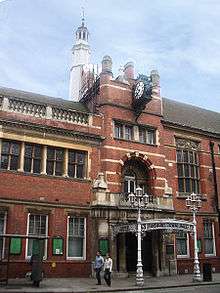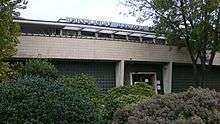Finsbury
Finsbury is a district of Central London, England. The area is a sub-district of Clerkenwell in the London Borough of Islington.
Finsbury was a manor which give its name to two much larger administrative areas: Finsbury Division of the Ossulstone Hundred of Middlesex, from the 17th century until 1900 and its successor until 1965 in a small part of its southern area, the Metropolitan Borough of Finsbury. Finsbury has given its name to an infantry unit — the Finsbury Rifles (originally known as the Clerkenwell Rifles) which saw distinguished service in several conflicts.
The area should not be confused with Finsbury Park, a public space roughly three miles to the north and which gives its name to its surrounding mainly residential area.
Location and Extent
The area has never been formally defined except in as far as it is part, as a manor, of the Ancient Parish of Clerkenwell. It lies immediately north of the City of London, east and north of central Clerkenwell, west of St Luke's, and south of Islington and City Road. The Finsbury Estate is in the western part of the district.
Etymology
The name is first recorded as Vinisbir (1231) and means "manor of a man called Finn".[1]
For a list of street name etymologies in the Finsbury area see Street names of Clerkenwell and Finsbury.
History

In the Middle Ages Finsbury was part of the great fen which lay outside the walls of the City of London.[2] It gave its name to the Finsbury division of the Ossulstone hundred of Middlesex.
In the early 17th century trees were planted and gravel walks made, and the area became a place for recreation. In 1641 the Honourable Artillery Company moved to Finsbury, where it still remains, and in 1665 the Bunhill Fields burial ground was opened in the area. Building on Finsbury Fields began in the late 17th century. The parish church of St Luke's was built in 1732–33, and at the end of the 18th century a residential suburb was built with its centre at Finsbury Square.[2]
In 1832 the parliamentary borough of Finsbury was created, covering a considerably wider area. In 1857 Finsbury Park was opened some three miles north, for the enjoyment of the residents of this parliamentary borough.[1] The City of London Yeomanry, founded at the time of the Second Boer War, made its headquarters in Finsbury Square.
The Metropolitan Borough of Finsbury in the County of London was created in 1900, covering the area of Finsbury and Clerkenwell, with Finsbury Town Hall located on Rosebery Avenue. In 1938, Dr. Chuni Lal Katial was elected mayor of Finsbury, making him the first Asian mayor in the United Kingdom. In 1942 the borough council erected a controversial bust of Vladimir Lenin at the site of a new block of flats in Holford Square (the bust was removed in the 1950s). The borough was abolished in 1965 and absorbed into the borough of Islington.
Famous residents
- George Cruikshank, the Victorian illustrator, lived on Amwell Street
- Violet Kray, mother of the gangster Kray brothers. Twins Ronnie and Reggie were arrested at her flat in Braithwaite House, Finsbury, in connection with gangland crimes including murder and fraud on 8 May 1968.[3]
- Eric Maxon, Shakespearean and early film actor, died in Finsbury
- Arthur Mullard, comic actor
- Dadabhai Naoroji[4]
Today
The name Finsbury is now most often used of the western part of the district, around the old parish of St James (now generally known as Clerkenwell), which is the home of the former Finsbury Town Hall, Finsbury Estate, Exmouth Market, the Sadler's Wells Theatre, Islington Local History Centre, Islington Museum and City University.
Transport
Nearest places:
Nearest London Underground stations:
Gallery
 Finsbury Town Hall
Finsbury Town Hall Lubetkin-designed Finsbury Health Centre
Lubetkin-designed Finsbury Health Centre Finsbury War Memorial
Finsbury War Memorial Finsbury Bank for Savings
Finsbury Bank for Savings
See also
References
External links


